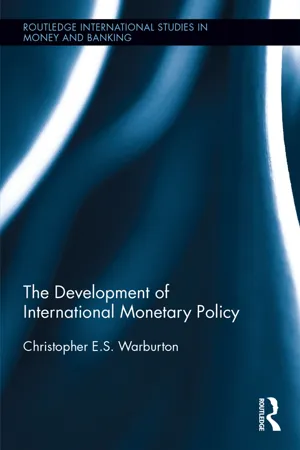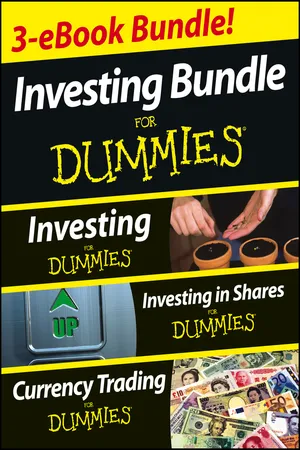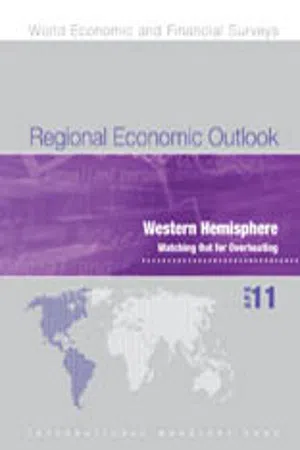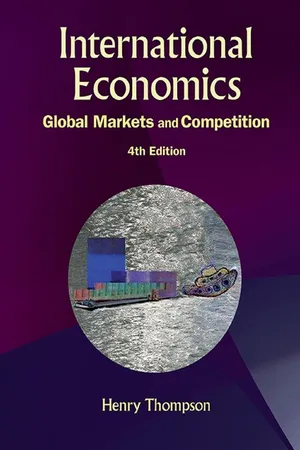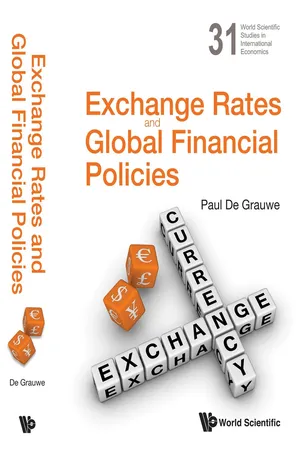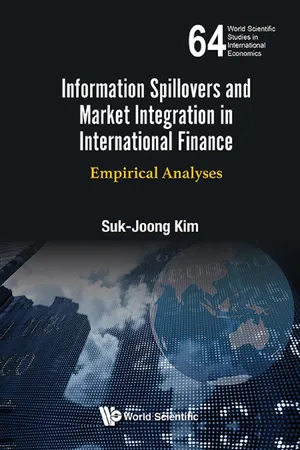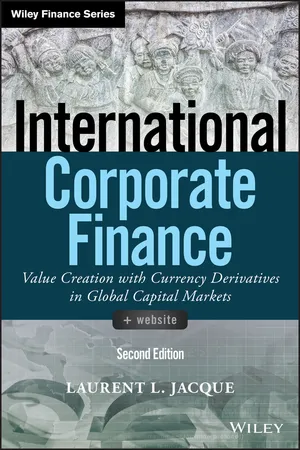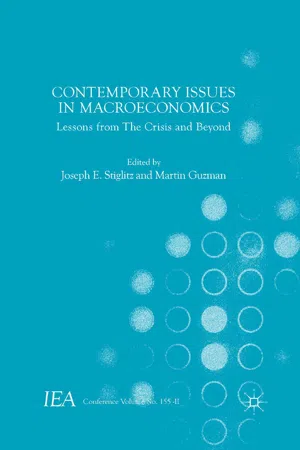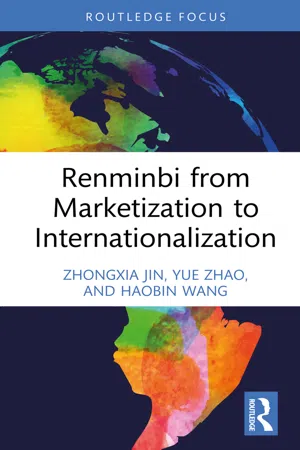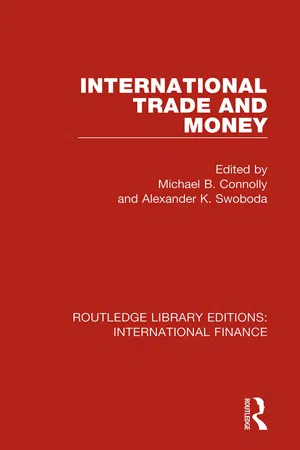Economics
Foreign Exchange Market Intervention
Foreign exchange market intervention refers to the actions taken by central banks or monetary authorities to influence the value of their currency in the foreign exchange market. This can involve buying or selling domestic currency to stabilize or manipulate its exchange rate. The goal of intervention is to maintain stability in the currency's value and support the overall economy.
Written by Perlego with AI-assistance
Related key terms
11 Key excerpts on "Foreign Exchange Market Intervention"
- eBook - ePub
- Christopher Warburton(Author)
- 2017(Publication Date)
- Routledge(Publisher)
7 Intervention in foreign exchange markets and the future of fiat moneyIn many ways, this chapter is an extension of Chapter 2 . It analyses the rationale for intervention in foreign exchange markets and the conditions under which intervention can be manipulatory. It also evaluates the viability of fiat money in the distant future, given the emergence of complementary electronic currency. The fundamental properties of money and the relevance of such properties are discussed.What are foreign exchange interventions? Foreign exchange interventions are the purchases and sales of foreign currency in foreign exchange markets to attain specific or multiple macroeconomic objectives. Foreign exchange markets are networks of financial institutions and brokers in which individuals, businesses, banks, and governments buy and sell the currencies of different countries. Foreign exchange market participants are generally interested in financing international trade, investing or doing business abroad, or speculating on currency price movements. Different currencies are traded on a daily basis to the tune of about $2 trillion in the FX market around the world.There are two primary types of transactions in the FX market: (a) spot transactions (agreement to buy or sell currency at the current exchange rate) to be settled in about two days, and (b) forward transactions in which traders agree to buy and sell currencies at predetermined exchange rates for settlement in at least three days. Businesses use forward transactions to reduce their exposures to exchange rate risk.Intervention in foreign exchange market is nothing new, but its excesses can be disruptive. Some of the fundamental and concerted reasons for regulating monetary policy were presented in Chapter 2 , paramount of which is the effort to prevent macroeconomic destabilisation. Invariably, the delictual effect of intervention is less precise because sovereign nations are legally permitted to ensure the stability of their economies as long as their methods do not threaten global financial stability. Recall the lawful customary and conventional monetary sovereign rights that were discussed in Chapter 2 - David Stevenson, Paul Mladjenovic, Tony Levene, Kathleen Brooks, Brian Dolan(Authors)
- 2013(Publication Date)
- For Dummies(Publisher)
That line is reserved for open market intervention by the central bank, and when it rings, it usually means only one thing: The central bank is intervening in the market. Intervention refers to central banks buying or selling currencies in the open market to drive currency rates in a desired direction. Direct intervention in the market is usually taken only as a last resort. It also may be a stopgap measure to stabilize markets upset by extreme events, such as a terrorist attack or rumors of a financial institution’s failure. When it’s not necessitated by emergency circumstances, markets are generally aware of the increasing risks of intervention. Open market intervention is usually preceded by several less-blunt forms of official intervention. The idea from the government’s point of view is to get as much bang for the buck as possible before committing real money. Remember: Central banks have limited firepower in relation to the overall market, so they have to pick their spots well. Sometimes, the government’s objective is simply to slow a market move to restore financial market stability, and less drastic forms of intervention are not yet necessary. Some of the more subtle forms of intervention are Verbal intervention or jawboning: These are efforts by finance ministry or central bank officials to publicly suggest that current market directions are undesirable. Basically, it amounts to trying to talk up or talk down a particular currency’s value. For example, if the Japanese MOF is intent on preventing further JPY strength to protect its export sector, but the USD/JPY rate keeps moving lower, senior MOF officials may indicate that “excessive exchange rate movements are undesirable.” This message signals currency traders to reduce their USD selling/JPY buying or risk the potential consequences- eBook - ePub
- International Monetary Fund. Western Hemisphere Dept.(Author)
- 2011(Publication Date)
- INTERNATIONAL MONETARY FUND(Publisher)
3. Foreign Exchange Market Intervention: How Good a Defense Against Appreciation Winds?
Emerging markets have increasingly relied on foreign exchange intervention to confront currency appreciation pressures arising from “easy external financing conditions.”Focusing on the last seven years, this chapter discusses the experience of selected Latin American economies with these policies, and compares them with those of other regions. It also examines the role of different modalities of intervention, and offers a new cross-country approach to assess its effectiveness and costs.Central banks intervene for various (nonexclusive) reasons, but the nature and time profile of their interventions often suggests an effort to mitigate currency appreciation pressures. When practicing intervention, a number of countries in Latin America rely on rules but these often leave significant room for discretion; it is unclear whether rule-based settings are more effective (in mitigating appreciation). Evidence suggests that interventions can slow the pace of appreciation, but such effects decrease rapidly with the degree of capital account openness; and interventions appear to be more effective when there are signs that the currency may be becoming overvalued. Costs associated with intervention often have been sizable, reflecting not only high interest rate differentials but also large valuation losses.Passage contains an image
3.1. Introduction
Abundant liquidity in global markets and a high exposure to international capital movements have put foreign exchange intervention (FXI) at center stage of the policy debate in Latin America. Despite the widespread use of FXI policies to confront the spillover effects of easy external financing conditions—including on exchange rates—there is no guarantee of their success. The empirical literature (focused mostly on advanced economies) has failed to reach a conclusion about the effects of FXIs on exchange rates, frequently suggesting their absence. Under current global conditions favoring capital flows to emerging markets, and with added currency appreciation pressures arising from marked changes in fundamentals—for example, terms-of-trade gains for commodity exporters—the effects of FXI have become even more difficult to grasp. Still, many central banks appear to believe in the effectiveness of FXI and continue to pursue such policies (see Neely, 2008 ; Bank for International Settlements, 2005 - eBook - ePub
Strained Relations
US Foreign-Exchange Operations and Monetary Policy in the Twentieth Century
- Michael D. Bordo, Owen F. Humpage, Anna J. Schwartz(Authors)
- 2015(Publication Date)
- University of Chicago Press(Publisher)
In the short run, intervention often generates losses, a point that Goodhart and Hesse (1993) also illustrate. Hence, it is possible that technical traders profit against central banks in the short run while central banks profit in the long term. This raises questions about the effect that sustained intervention might have on the functioning of private foreign-exchange markets. 25 1.7 Road Map This chapter has presented background material on foreign-exchange intervention and on the US institutional framework for that intervention. The remainder of this book explains how theories of intervention and institutional arrangements evolved in the United States, primarily during the twentieth century. The key concern is how these developments interacted with monetary policy. As chapter 2 explains, precedents for modern foreign-exchange-market operations are found in European experience with the classical gold standard, but they quickly grew and developed after World War I as countries first attempted to return to the gold standard and then reacted to the Great Depression. European central banks under the classical gold standard often bent the “rules of the game” through discount policies and gold devices. These were early exchange-market operations. Some European central banks held foreign-exchange reserves and stabilized their exchange rates within the gold points through intervention. Chapter 2 illustrates early uses of secrecy, sterilization, and forward transactions—all of which become important characteristics of modern interventions. The chapter also discusses the establishment of the British Exchange Equalisation Account, which directly intervened in the foreign-exchange market. American antecedents also aided the development of foreign-exchange operations in the United States. Chapter 2 explains the rise of private firms that specialized in the spatial and temporal arbitrage of sterling bills and related instruments - eBook - ePub
International Economics
Global Markets and Competition
- Henry Thompson(Author)
- 2017(Publication Date)
- WSPC(Publisher)
Peter Kenen (Princeton) argues that governments should intervene to stop runs on FX markets. Ronald McKinnon (Stanford) argues for active management of FX rates. John Williamson (Institute for International Economics) favors active intervention and recommends joint action by central banks. Jacob Frankel (IMF) thinks better fiscal and monetary policy should be the focus. Martin Feldstein (Harvard) believes market forces should be allowed to determine FX rates.Section B Problems
B1. Suppose China wants to undervalue the yuan. Diagram the FX market for yuan and illustrate the artifically low exchange rate. How could the central bank sustain this rate? Why would it want to?B2. How could the Chinese government use FX market controls to keep the yuan below its market value?B3. Justify your opinion on fixed versus floating exchange rates.C. FOREIGN EXCHANGE TRADING
The FX market involves buying and selling foreign currency. Topics in foreign exchange trading include: •Expectations and exchange rates •Stability of exchange rates •Triangular arbitrage across currenciesExpectations and FX Rates
Traders expecting a currency to appreciate will increase demand in the FX market. The increased demand appreciates the currency. Market expectations make themselves come true.Much of the hourly and daily changes in FX rates is due to traders looking for short term gains. Long term investors want to hold assets in currencies expected to maintain or appreciate. There is motivation for investors with cash in high inflation countries to buy assests in low inflation countries.Expectations influence the spot exchange market. Expectations explain the dollar depreciation that started in 1985 when the central banks of Germany, France, Britain, Japan, and the US announced they would act together to sell dollars. Traders and investors expected the dollar to depreciate. The volume of central bank sales was trivial but trader expectations moved the market. In 1989 the dollar appreciated in spite of dollar sales by central banks. Central banks control their money supplies, determining inflation and exchange rates. - eBook - ePub
- Paul De Grauwe(Author)
- 2014(Publication Date)
- WSPC(Publisher)
t we obtainwhere Xt = ΔZt /N, i.e., the supply of foreign assets per capita. We have also assumed that there are only two types of agents, i.e., chartists and fundamentalists (subscripted by c and f, respectively).Eq. (3) makes clear that the effect of a Foreign Exchange Market Intervention on the exchange rate will be difficult to predict ex ante because it depends on the weights the chartists and fundamentalists have in the market, together with the forecast errors they have been making in the past. In other words the effect of interventions will depend on the market structure and the risk perceptions at the time of the intervention. Since these factors change continuously, the effect of interventions will also change.It should also be stressed that we analyse the effects of sterilized interventions here, i.e., interventions that are not allowed to affect domestic money market conditions, including the domestic interest rate. Thus, we analyze interventions that do not affect the fundamentals.6We investigate the question of the effectiveness of interventions assuming a simple intervention rule. The intervention rule we consider is one in which the central bank is continuously in the market smoothing the movements of the exchange rate by using a “leaning against the wind” intervention rule.7 We specify this rule as follows:where ζ ≥ 0. Thus when the exchange rate increases (decreases), the central bank sells (buys) foreign exchange in the market so that the supply of foreign assets increases (decreases). The parameter ζ measures the intensity with which the central bank performs these operations. Note that as in the case of the private agents the current exchange rate is not in the information set of the central bank. The current exchange rate is the market clearing exchange rate that will be the outcome of the decisions of both the private agents and the central bank, but is not yet known when agents make their decision. This is in the logic of the behavioural finance model used here. Individual agents (both private and public) lack the cognitive skills to understand “the whole picture,” i.e., they do not know the underlying model which they need to know to compute the market clearing exchange rate in period t - eBook - ePub
Information Spillovers and Market Integration in International Finance
Empirical Analyses
- Suk-Joong Kim(Author)
- 2017(Publication Date)
- WSPC(Publisher)
However, official interventions by the BOJ were ineffective at best and market disturbing at worst prior to 1995. Specifically, a Yen purchase (sale) was associated with a Yen depreciation (appreciation) on the day of intervention which might lead to an erroneous conclusion of intervention ineffectiveness. There has also been some evidence that interventions were associated with an increase in foreign exchange volatility, and consequently, had an adverse effect of destabilising the market (Beine, 2004; Nagayasu, 2004; Frenkel et al., 2005). Over recent years, the BOJ has been claimed to have intervened mostly in a secret manner. Beine and Bernal (2007) report that about 80% of total transactions during 2003–2004 were not publicly known at the time of intervention. A secret intervention is executed in such a way that allows a central bank to influence the exchange rate without sending any signal about its presence in the market. Previous literature has suggested that a central bank will opt to intervene covertly for many reasons. First, there may be occasions where there is a need to intervene to correct a current trend in exchange rate movements but such a move would contradict the current monetary policy objective. Such a misalignment in policy objectives would require a secret foreign exchange intervention so as to achieve the foreign exchange aim without losing a monetary policy credibility (Chiu, 2003). Second, if the bank experiences a low level of credibility or there is a record of past failures in influencing the currency (Dominguez and Frankel, 1993), publicly known interventions, unless they are substantially large and repeated (and possibly coordinated with other central banks) may not achieve desired outcomes as market will not value the information contained in the intervention - eBook - ePub
International Corporate Finance
Value Creation with Currency Derivatives in Global Capital Markets
- Laurent L. Jacque(Author)
- 2019(Publication Date)
- Wiley(Publisher)
ex post basis from variations in the level of central banks' foreign exchange reserves.- In a system of stabilized exchange rates, the central bank is contractually committed to maintaining the prevailing exchange rate within a narrow, publicly defined band of fluctuations. Clearly, uncertainty about future spot exchange rates is, barring a major devaluation or revaluation, the reason this system is often referred to as a system of “pegged yet adjustable” exchange rates, bounded from the standpoint of market participants.
- Under a system of controlled exchange rates, the central bank supersedes the marketplace by becoming the sole buyer and seller of foreign exchange. The rate at which transactions take place is no longer determined by the interaction of supply and demand forces; rather, it is the end product of bureaucratic decisions. Furthermore, buying and selling rates are not necessarily identical, nor are selling and buying rates uniform across all foreign exchange earnings or payments-generating transactions.
QUESTIONS FOR DISCUSSION
- What is the difference between a “clean” float and a “dirty” float?
- Why do countries intervene in their foreign exchange markets?
- What is the difference between currency convertibility and exchange rate flexibility?
- Explain how central bank intervention allows a country to keep its forex rate at a certain level.
- What is the difference between central bank intervention in the foreign exchange market in the context of floating versus stabilized exchange rates?
- How would you contrast a controlled exchange rate with a stabilized exchange rate?
- What does the explosive growth in China's reserves tell you about the nature of its exchange rate regime?
- The last time the U.S. Federal Reserve Bank intervened in the forex market was in 1995. Would you expect the U.S. foreign exchange reserves to have increased or decreased over the past 18 years?
- eBook - ePub
Contemporary Issues in Macroeconomics
Lessons from The Crisis and Beyond
- Joseph E. Stiglitz, Joseph E. Stiglitz, Kenneth A. Loparo, Joseph E. Stiglitz, Martin Guzman(Authors)
- 2016(Publication Date)
- Palgrave Macmillan(Publisher)
Bangko Sentral Review, vol. V, pp. 1–25.Adler, Gustavo, and Camilo E. Tovar (2011) “Foreign Exchange Intervention: A Shield Against Appreciation Winds?,” IMF Working Paper No. 11/165. Barabás, Gyula (2003) “Coping with the Speculative Attack Against the Forint’s Band,” MNB Background Studies, 2003/3.Disyatat, Piti, and Gabriele Galati (2005) “The Effectiveness of Foreign Exchange Intervention in Emerging Market Countries,” Foreign Exchange Market Intervention in Emerging Markets, BIS Paper no. 24, pp. 97–113.Domaç, Ilker, and Alfonso Mendoza (2004) “Is There Room for Foreign Exchange Interventions Under an Inflation Targeting Framework? Evidence from Mexico and Turkey,” World Bank Policy Research Working Paper No. 3288, April.Ghosh, Atish R. (1992) “Is it Signaling? Exchange Intervention and the Dollar-Deutschemark Rate,” Journal of International Economics, vol. 32, nos 3–4, pp. 201–20.GuimaraÞes-Filho, Roberto F., and Cem Karacadag (2004) “The Empirics of Foreign Exchange Intervention in Emerging Market Countries: the Cases of Mexico and Turkey,” IMF Working Paper 04/123. Holub, Tomáš (2004) “Foreign Exchange Interventions Under Inflation Targeting: The Czech Experience,” Czech National Bank Internal Research and Policy Notes, No. 1, Czech National Bank, January.Jeanne, Olivier, and Andrew K. Rose (2002) "Noise Trading and Exchange Rate Regimes," Quarterly Journal of Economics, vol. 117, no. 2, pp. 537–69.Kamil, Herman (2008) “Is Central Bank Intervention Effective Under Inflation Targeting Regimes? The Case of Colombia,” IMF Working Paper 08/88. Mandeng, Ousmène (2003) “Central Bank Foreign Exchange Market Intervention and Option Contract Specification: The Case of Colombia,” IMF Working Paper O3/135.Ostry, Jonathan D., Atish R. Ghosh, Karl Habermeier, Marcos Chamon, Mahvash S. Qureshi, and Dennis B. S. Reinhardt (2010) “Capital Inflows: The Role of Controls,” IMF Staff Position Note 10/04 (Washington, DC: International Monetary Fund).Ostry, Jonathan D., Atish R. Ghosh, Marcos Chamon, and Mahvash S. Qureshi (2011) “Capital Controls: When and Why?,” IMF Economic Review - Zhongxia Jin, Yue Zhao, Haobin Wang(Authors)
- 2022(Publication Date)
- Routledge(Publisher)
Source: Das et al. (2020). Note: Das et al. (2020) estimate external investment returns using the IMF’s cross-border investment stock and flow data, see Gourinchas and Rey (2007) for more details regarding the methodology.FXI can also inhibit the development of foreign exchange derivatives markets. FXI, in practice, may not always involve direct purchases and sales in the spot market, but may alternatively take place in the derivatives markets with policy measures such as requiring payment of foreign exchange risk reserves. Intervention in the derivatives market serves the purpose of countering depreciation or appreciation pressure without directly tapping foreign reserve assets. An important side effect of FXI in the derivatives market is that the distorted price or additional cost of hedging as a result of intervention policies may drive away investors who have real hedging needs, thereby creating market barriers to risk-management tools. Such intervention policies contradict a sustainable market-based approach to risk management and can result in underdevelopment of the derivatives market. Hofman et al. (2020) found that the case for FXI appears strongest in countries with severe currency mismatch and underdeveloped markets. Their findings suggest that sustained use of FXI may entrench adverse initial conditions such as an underdeveloped market, giving rise to a negative policy-induced feedback loop.Another costly consequence of FXI is that it can put the central bank in a dilemma by creating conflicting goals between inflation and exchange rate targets. An important mandate of the central bank is to maintain price stability, but inflation targets may be compromised if the central bank simultaneously attempts to achieve an exchange rate target. Granted, there are circumstances under which inflation targets are compatible with exchange rate targets. For example, when a country tries to combat deflationary pressure, FXI that sells domestic currencies in exchange for foreign currencies helps ramp up inflation. Similarly, when a country experiences inflationary pressure, FXI that sells foreign currencies in exchange for domestic currencies helps rein in inflation. However, under many circumstances in practice, the objectives of FXI often conflict with inflation targets. For instance, countries often resort to FXI under a crisis scenario with a rising current account deficit, capital outflows, exchange rate depreciation, and deflation. FXI that involves reserve sales may reinforce deflationary pressure if no immediate and complete sterilization policies are in place. On the other hand, reserve accumulation typically takes place under a rising current account surplus, capital inflows, appreciation pressure, and inflation. Hence, FXI that is not fully sterilized could further fuel inflation.- eBook - ePub
- Michael B. Connolly, Alexander K. Swoboda(Authors)
- 2018(Publication Date)
- Routledge(Publisher)
PART IIIINTERNATIONAL MONETARY ANALYSIS
Passage contains an image
I. INTRODUCTION7
A Model for the Analysis of Official Intervention in the Foreign Exchange Markets
GIORGIO BASEVI
University of LouvainandUniversity of BolognaThis study has three main objectives. The first is to provide a framework for analysing the internal monetary effects of surpluses and deficits in the balance of a country’s international payments. In published models of the foreign exchange markets, both theoretical2 and empirical,3 there typically is no link between the determination of exchange rates, on the one hand, and interest rates on the other. Yet, capital movements are described and estimated, in these models, as determined by the joint influence of such variables. This missing link might very well go far toward explaining the weak statistical results that are generally obtained in these models, especially with regard to the sensitivity of capital movements to exchange rates or to covered interest rate differentials. Even in the economy-wide models that have been constructed and estimated for various countries in recent years, the channels through which external surpluses (deficits) inject (absorb) liquidity into (from) the economy is not clarified in a detail sufficient for the analysis of the connections between foreign exchange policy and monetary policy.The second objective of this study is to provide a framework for analysing the foreign exchange market in all its sections; mainly those determining the spot and forward rates, but in principle also those determining the rates for various maturities of forward exchange contracts. In estimated macroeconomic models only the spot exchange rate is endogenous, while forward rates usually are either ignored or exogenous.4
Index pages curate the most relevant extracts from our library of academic textbooks. They’ve been created using an in-house natural language model (NLM), each adding context and meaning to key research topics.
